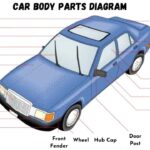Navigating the world of car parts online can be confusing, especially when you encounter terms like “left” and “right.” If you’re scratching your head wondering which side is which when ordering components like wishbones or control arms, you’re not alone. This guide will clarify the automotive left and right, ensuring you order the correct parts every time.
Driver’s Seat Perspective: Your Key to Left and Right
The simplest and most reliable way to determine left and right for car parts is from the driver’s seat. Imagine yourself sitting in your car, facing forward as if you were driving.
- Left Side: This is the side of the car to your left when you are seated in the driver’s seat. In countries with right-hand drive (like the UK or Japan), this is the passenger side of the vehicle. In left-hand drive countries (like the USA or Germany), this is the driver’s side.
- Right Side: Conversely, the right side is the side to your right when you’re in the driver’s seat. For right-hand drive cars, this is the driver’s side, and for left-hand drive cars, it’s the passenger side.
This perspective holds true regardless of where the car parts are manufactured or where you are ordering from. Whether the parts are coming from Germany, the US, or anywhere else, “left” and “right” are universally understood from the viewpoint of the driver sitting in their car.
What About “Near Side” and “Off Side”?
You might occasionally come across older terms like “near side” and “off side.” These are less common now and can be confusing, so it’s best to stick with “left” and “right” for clarity. However, for context:
- Near Side: Traditionally, in right-hand drive countries, the near side was the side of the car closest to the curb or pavement edge. This equates to the passenger side or left side.
- Off Side: The off side was the side further away from the curb, meaning the driver’s side or right side.
These terms are fading out of use because they are country-specific and less intuitive than left and right. When ordering car parts online, always prioritize “left” and “right” designations based on the driver’s seating position.
Front and Rear – Equally Straightforward
Just like left and right, “front” and “rear” are also determined from a straightforward perspective:
- Front: The front of the car is the direction the car normally moves in, where the headlights are located.
- Rear: The rear is the opposite end of the car, where the taillights are located.
These terms are generally less confusing but are worth mentioning for completeness.
Examples: Putting Left and Right into Practice
Let’s say you need to replace a wishbone or control arm, as mentioned in the original forum post. If you need the one on the passenger side of a left-hand drive car (like in the USA), you would order the “left” control arm. If you needed the same part for the passenger side of a right-hand drive car (like in the UK), you would still order the “left” control arm.
Understanding this driver’s seat perspective is crucial for accurately ordering a wide range of car parts, including:
- Headlights and Taillights
- Mirrors
- Control Arms and Suspension Components
- Brake Calipers
- And many more!
Conclusion: Order with Confidence
When it comes to ordering car parts and deciphering “left” and “right,” remember the golden rule: it’s all relative to the driver’s seat. By keeping this perspective in mind, you can confidently navigate online catalogs and ensure you’re selecting the correct components for your vehicle, no matter where you are in the world. This simple understanding can save you time, money, and the frustration of ordering the wrong part.
